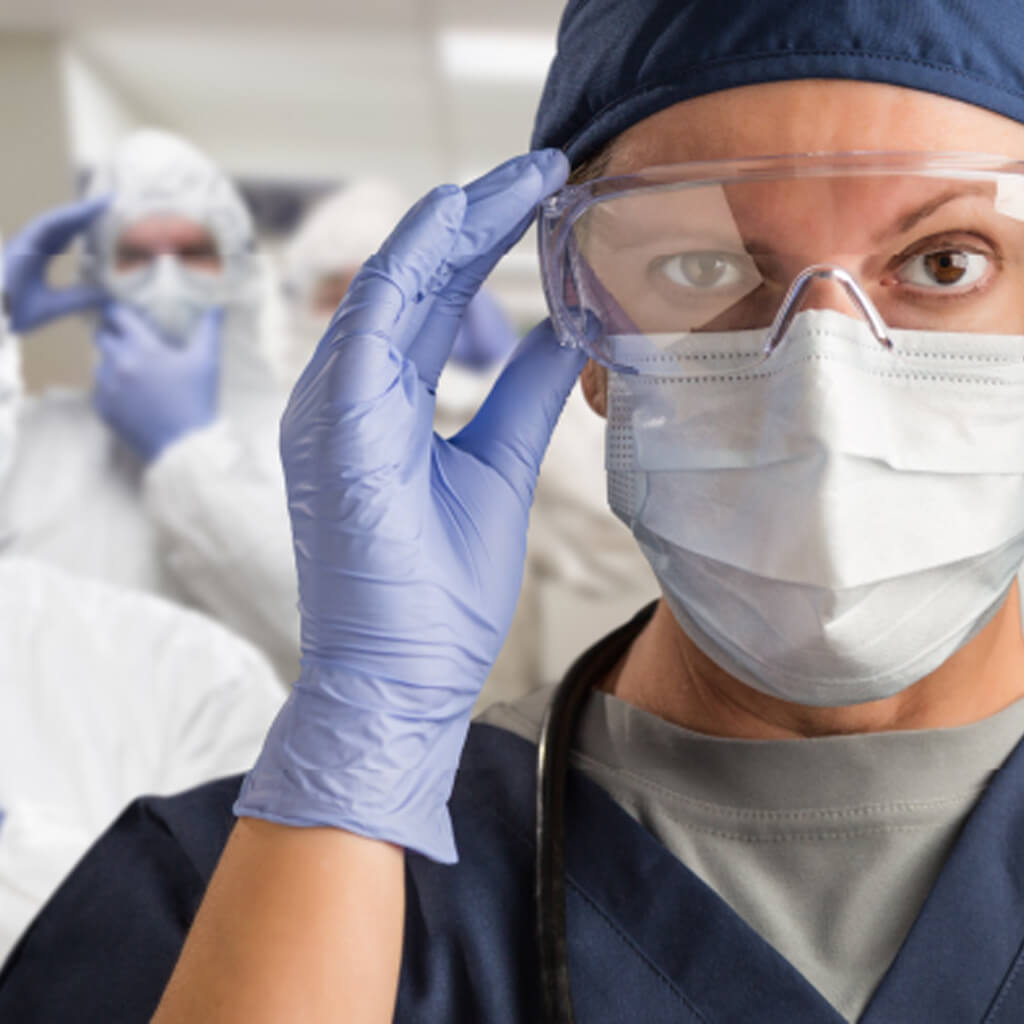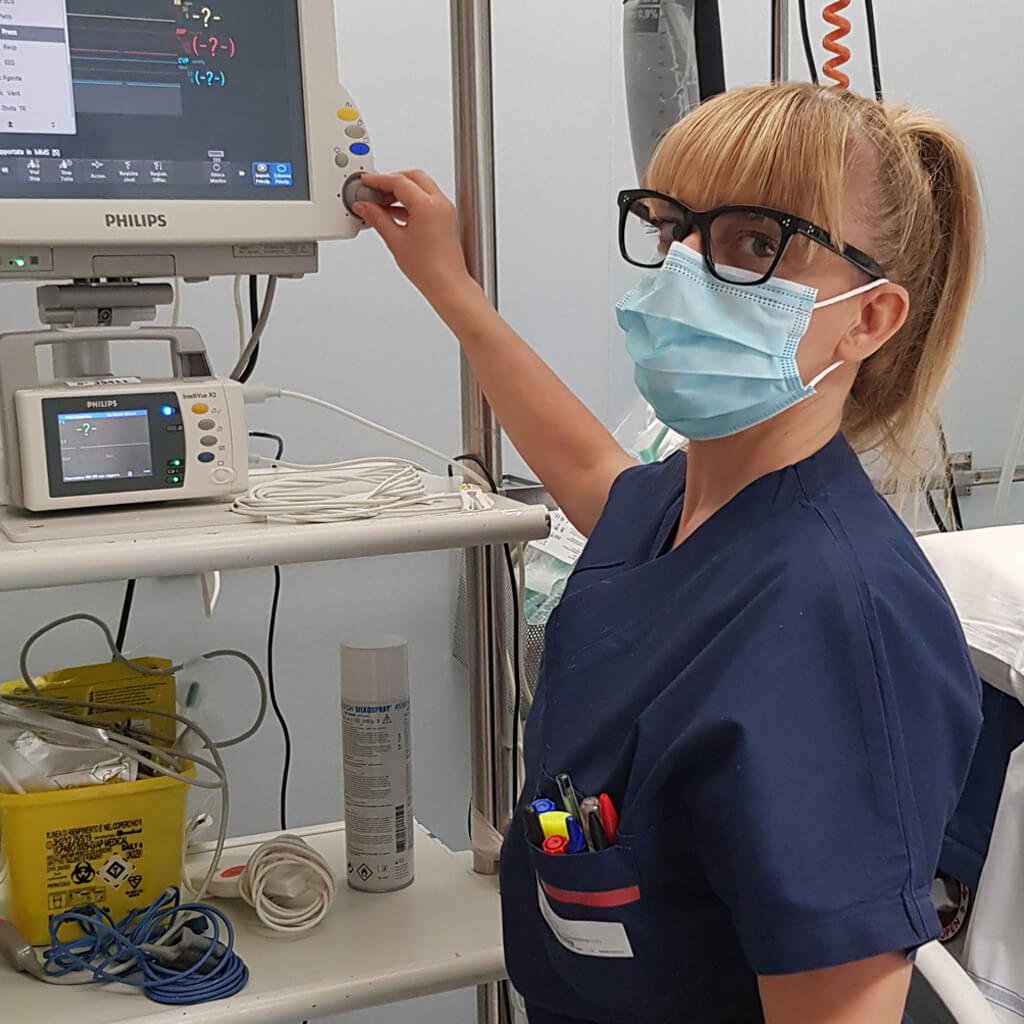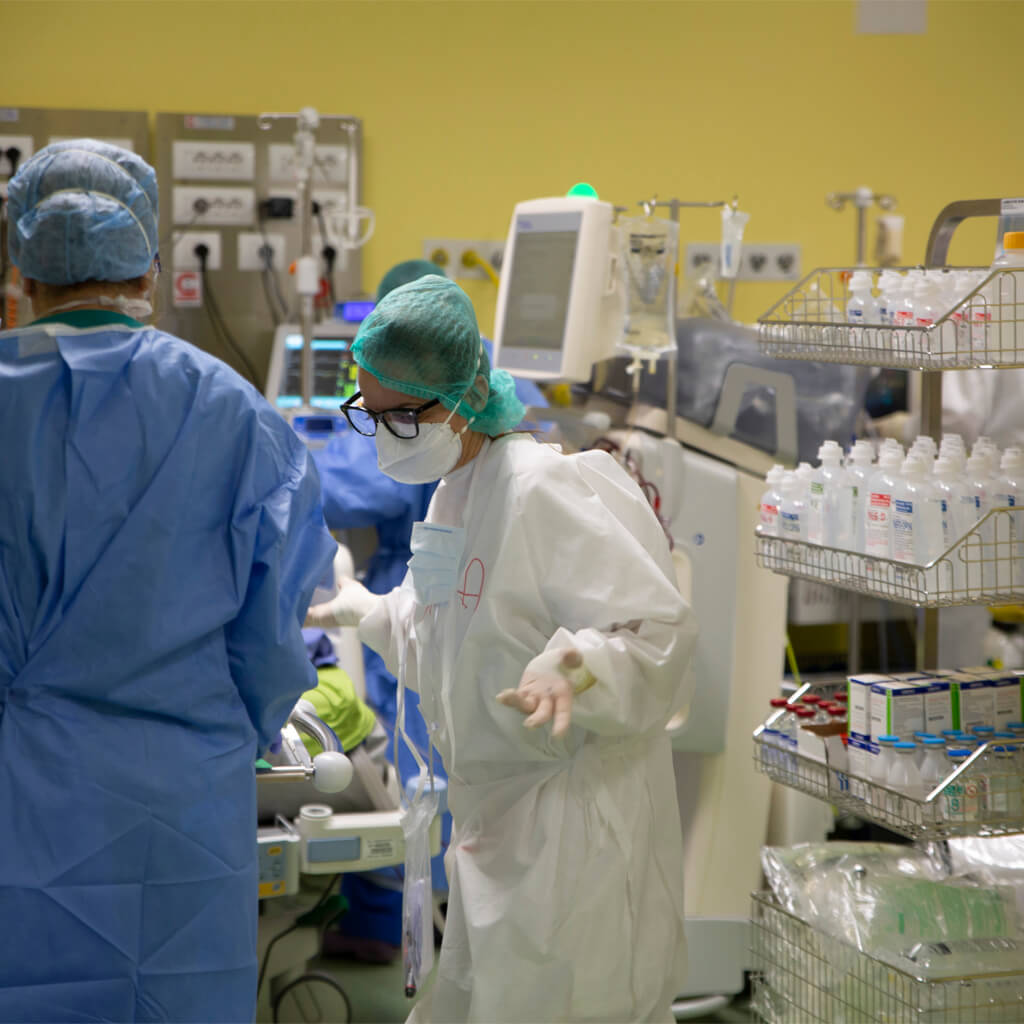Covid-reanimation nurse: out of all the known schemes

Publication date: 23-06-2020
Updated on: 14-02-2023
Topic: Covid-19
Estimated reading time: 1 min

Article Author
Viktoryia Luhakova
Medical Editor
Emanuele Caldarella
Editor and Translator
Viktoryia LuhakovaProfession of a nurse requires courage, resourcefulness and dedication. Being a nurse certainly means knowing how to love what you do. During the world pandemic they were among few who faced the COVID-emergency on the frontlines. We asked the Nurse Coordinator at the coronavirus intensive care unit Pallario 1 at the San Raffaele Research Hospital, Carla Molteni, to share her experience and thoughts on the future
You work at the San Raffaele Hospital, tell us what is your role and duties; since San Raffaele has been one of the hospitals to take care of many COVID-19 patients, how your job has changed since the pandemic?

If you had asked me this question a few months ago I would have answered, without hesitation, that I was a nurse care coordinator in the Coronary Intensive Care Unit of the Cardiac Surgery Intensive Care Unit at the San Raffaele Hospital. However, this concept has changed a lot during the pandemic for a simple reason: each coordinator lives attached to a physical structure of the ward - you know the dynamics, you know the group, the relationships. Every day there is the unexpected around the corner but everything is well planned, even if it is a reanimation. With the emergency, life of every employee was turned upside down in just one day. We found ourselves transforming the hospital: entire divisions were closing, units hosted patients with completely different pathologies compared to what they were used to. This forced every coordinator to leave their comfort zone and, in fact, reinvent oneself by learning how to manage emergency situations with completely new collaborators. For example, Pallario 1, tensioning ICU structure [an additional ICU for the needs of COVID emergency was built with funds donated on crowdfunding platform in only 2 weeks – Ed.], was opened on the same place where a week before people played soccer and basketball, and later 14 highly complex patients were moved there. We went from 30 to 64 reanimation beds. I can assure you that it takes years to train a nurse of that level. An experienced resuscitation nurse has to work in different environments for a long time. Instead, we built an organizational model that was effective, we were able to assign an experienced nurse to all ICU beds while new reanimation spaces were gradually opening. It meant to create a hospital from a scratch: to redefine procedures, routes, from the smallest thing as a wardrobe could be (uniforms for the staff, those who deliver them, when to pick them up), kitchen, linens, transportation of the test tubes, recovery of materials and drugs, etc. Consequently, today I answer that I am a coordinator. Point. I learned by unhooking myself from what was a physical structure where I was working. We revisited our way of working and I am still impressed by our, mine and of all our collaborators, capacity to adapt. It is absolutely remarkable.
San Raffaele itself was impressive. You passed in the corridors of empty units, in silence, the nature of the environment in which we used to live every day was distorted. Without relatives, without patients waiting, with defined paths, without staff we could move freely. Different tools had to be used to communicate with administration offices and services. It was no longer allowed to move freely from one department to another, but technology must have been used: an email or a cellphone rather than other methods. We have rebuilt by helping and supporting one another. There were a lot of people from the other departments who made themselves available to help us in this difficult period. For example, there were colleagues from pediatrics, cardiovascular, urology, from the most different fields. They stood side by side with resuscitation nurses and took a huge load of responsibility. They worked in a great team taking care and assisting patients with a very high level of complexity. The fact of having a great team has been the trump card: it has allowed to come out, let's say, victorious from this period.
We came out of all the schemes and routines known. Nobody was prepared for such a thing. We studied procedures for maxi emergencies, as a catastrophe or a war. Back then it was a war, I worked on the lanes of magnitude nobody was prepared.
After what we have experienced, there is a reflection to do with respect to what will be done in the future. It is a logical need to maintain social distancing, avoid gatherings. We lived here, on the first line in the hospital, and we noticed that our work had to take on completely different aspects compared to what it was on the previous day, but this will also be the case for social life.
The protection of the hospital staff became a crucial topic during the pandemic. What special protective equipment were you provided to stay safe?

Regarding personal protection devices, protocols had been codified since the beginning. The protocols gave indications on what type of device to use in a certain zone of work. For example, in the areas that accommodated COVID-patients, the staff had to wear what we call "the first skin", waterproof protective gowns or water-repellent suits, filtering facepieces, surgical mask, headphones, gloves, over-glasses. These devices were already known to us and they were already used in other situations. The big problem was the overall consistency of the devices. At some point we had difficulties with having the numbers that were necessary, so we adopted new strategies. If, for example, we think of reanimations in COVID departments, in addition to the first skin, the direct assistance of the patient required wearing additional devices such as a waterproof protective gown. The gown did not remain attached to a single operator, but remained at a bedside of the patient in order to be used by other operators. Obviously, these gowns did not have to be visibly contaminated. When, for example, we run off waterproof protective gowns, we had plenty of coveralls instead. We cut the legs of the coveralls, transforming the coveralls into overalls. We have arranged with what we had, guaranteeing protection of the personnel. This is the fact given by the serological tests that were subsequently carried out after the swabs. The staff was well-protected anyway.
How often have you and your colleagues been tested?

As for the test (which may be the serological test or the swab) there was a codified procedure for different groups of the health workers: exposed cases, in contact with a COVID-patient, health workers who could manifest symptoms, depending on a situation the swab was indicated or not indicated. We followed the regional resolutions, the ministerial circulars and indications given by the World Health Organization. For example, personnel moving from COVID to non-COVID departments had to do the swab, indications were also relevant to behavior and body temperature. The serological surveillance was performed on an optional basis and staff may or may not adhere to the sampling operations, in case the serology was positive, the swab was carried out.
As far as we discussing protective devices, there were difficult times, I do not deny it. However, following the protocol that gave precise indications on when / where to use them has protected us a lot. It allowed the stocks to be distributed where there was a real need. Proof of this is the fact that we do not have as many staff exposed. It means that protection has worked.
As for the tests, once we did not have the reagents, it was difficult to do everything at the same place. There is a sea in between how we would like things to be and the real world. It is a system that, in my opinion, has worked for the San Raffaele.
The indications changed daily. We are not talking about years that we have lived with a slowly evolving situation. It was a tsunami. We found ourselves with a wave upon us with which we had to cope somehow. Surely the availability of clear protocol gave us a lot. It was kind of a rescue anchor. When we had doubts, we knew that we had to follow these indications and it guided us through a difficult time like a lighthouse in the fog.
We know that lots of physicians and nurses in the areas affected by the pandemic all over the world have left their homes and families to avoid their relatives’ contraction. Has your life been radically changed in this way as well?

Keep in mind that I have an 18-year-old daughter. We are not superheroes and do not have a magic wand that can protected us from anything. Logical that there is fear. You tried to protect yourself with devices, to manage the situation better, but the fear of being infected was always present. Obviously, besides being worried about my health, I was worried to contaminate my family. As soon as I felt that the situation became more and more pressing and heavy, I’ve sent to my daughter to live with my sister who was in smart working, what made me feel even more secure. At home we applied the protocol that was given by the Hospital’s infection committee on the management and risk reduction at home. I considered myself potentially infected, so my husband and I slept in separate rooms, used separate bathrooms. It was quite impossible to see each other, because I worked from 07:00 to 22:30. At the moment my husband panicked, we had more disinfectants at home than at the hospital, he washed door handles as if he had the incarnated COVID-19 in front of him. I have certainly adopted all the strategies for the safety of family members. I must say that, fortunately, nobody got sick. I consider myself a lucky person.
I believe that my attitude and my behavior, even subsequently, conditioned the behavior of others. Even my brothers have been very attentive and rigorous to respect all indications. I was like an example: they saw that my attention to protection was high and they tried to maintain the same standard within their homes. I have never been a person to magnify the phenomenon, I have always been attached to reality. When my family members saw that I assumed an attitude of this type, consequently they believed that the situation was not oversized but it was the correct thing that had to be followed.
What does a typical day on a ward look like? What is involved in caring for a patient with coronavirus? What’s the typical pathway?

Bear in mind that the literature on this virus is very scarce, there is very little data. We found ourselves facing a problem without guidelines, protocols, procedures. Initially it was quite disheartening, I had people who were frankly embittered, it seemed that they were no longer able to cure anyone. It took time, a long time. For each patient, a strategy had to be personalized by observing him/her, we paid attention differently in each person (how to set up the ventilator, how to cover the patient). This required a lot of effort. Equipped from head to toe with devices for 12 hours a day, it really costed a huge effort. But slowly we started to know this disease, what it could provoke, what attitudes were to be adopted to have the best results in the shortest time, the first extubated. This brought everyone to have a team strategy: there were no longer the doctor, the nurse, the physiotherapist. The team was the only one who worked on the patient according to the needs, levels of assistance required by the assisted person. This was the winning game, because gradually we started to see the successes. Especially in reanimation, in Pallario 1, which took patients transferred from other reanimations with a respiratory problem refracting any treatment. With time we learned that it took a long time to recover. What also worried us, if it takes all this time to cure a case, the reanimation beds were not enough. Later a trend was reversed and the sick slowly began to recover until they were dismissed from the hospital.
What are the means of emotional and psychological support you use for patients? For family members who might have a COVID-19 patient within a family, especially with visitors limited, any advice for checking on their relative?

In this case, technology has helped a lot. There were indications given by the Ministry of Health regarding the fact that family members couldn’t come to the hospital to visit their loved ones except for particular situations that were discussed with the therapist. Tools like iPad and a cellphone helped to put each patient in direct contact with their family. This have had the highest emotional impact. I still remember the first phone call of a patient with her family members, they were crying after days not seeing the loved one. At the same time, a psychological support service was created in the hospital and several families were invited to talk in order to help them to cope with a period of detachment and try to work out this difficult period.
Today, when we can finally admit that the first wave of the pandemic is over, what do you consider was the biggest challenge of the past months?

The first challenge was structural and logistical and related to the laboratories: all paths were changed, the hospital was transformed, new departments were created, other departments stopped working. Obviously, this was determined at reshaping the hospital’s operations.
The second challenge was the opening of the new reanimation facility where I used to play basketball a week before. It was built with an integrated surgical theater, a sterilization room, CT and advanced technology.
It was created in a separate place with the procedures to be defined starting from the smallest to the most complex ones, and of course staff training. We found ourselves having to work with nurses with minimal skillset. I must admit that I had a fantastic team, they even created flow chats to help colleagues. I repeat, staff training was a challenge, we used the winning model but first and foremost everyone was concerned. It meant putting a patient of a very high complexity in the hands of staff with less skills. But it worked. Less experienced staff expressed an extraordinary will for training and for afterhours studies.
Then, keep in mind that we had to use all new devices. It is similar as to pass from a Fiat 500 to a Ferrari – in the beginning you must understand how to drive it. We made video-lessons with technicians, we also created a chat where the videos were published so the ones who weren’t present could be trained remotely. When I talk about training, practically I mean from Saturday to Monday. On Saturday we went to set up the facility and on Monday we accommodated 14 patients. In 2 days, we had to do everything.
Now we are worried about the time needed for the re-conversion of the hospital to restore it to its original state. This won’t be easy. Converting a COVID-department to a non-COVID one requires commitment, resources and a series of procedures that block operating units for days. Sanitization, quarantine the devices, sterilize all the materials, perform the swab on the personnel, wait for the results of the swab to be able to absorb it. In short, it is a considerable commitment.